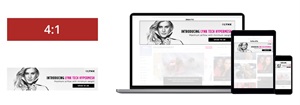
Top stories






More news












The main “perk” of the new ad portfolio is that ad units will now feature flexible formats to seamlessly adapt across screens. This essentially means that online ads will be responsive to the screen-size and container that it is served on. This is a significant change from the previous method of creating multiple banner sizes for each container across desktop and mobile platforms.
The major change is that ad sizes are now defined by ratios and NOT pixels as it were before, e.g. A banner is now defined as 4:1 instead of 728x90.
These banners are designed in HTML5 and are pixel independent in order to retain image clarity- enabling the banners to look crisp all the way from mobile up to a retina display desktop.
The reason is partly to benefit the advertiser and partly to benefit the user. The new ratios mean the ads will fit into the website correctly, ultimately being in line with the site’s existing content and not just looking like a lick’n’stick placement which we see all too often. All while being suitably served cross-platform.
The users will benefit from the new LEAN (Light, Encrypted, Ad Choice Supported, Non-Invasive) guidelines. Which will ensure better user experience and control, according to President and CEO of IAB, Randall Rothenberg. Some of the ways to ensure this include: user-initiated videos and ad expansions, an ever-present close button and a disposal of pop-up ads, forced countdowns and hover-to-expand actions.
Expect to see transition guidance and ad container details from the beginning of 2017, with code libraries becoming available to industry to support the change by mid 2017.
That being said, it is important that media agencies, publishers and designers get on board as quickly as possible in order to make this the global standard.